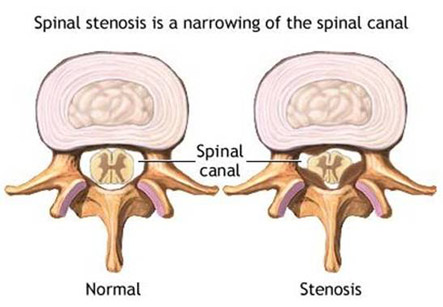Spinal Stenosis
Introduction
Spinal stenosis is the narrowing of spaces in the vertebral bones of spine which causes pressure on the spinal cord or nerves. About 75% of cases of spinal stenosis occur in the low back (lumbar spine). In most cases, the narrowing of the spine associated with stenosis compresses the nerve roots. This compression can cause pain along the back of the leg.
Causes:
There are many potential causes for spinal stenosis, including:
1. Aging: With increasing age, the body’s ligaments (tough connective tissues between the bones in the spine) can thicken. Small spurs of bone may develop from the vertebrae and into the spinal canal. The cushioning disks between the vertebrae may begin to degenerate. The facet joints (flat surfaces on each vertebra where the adjacent vertebrae join each other) also may begin to break down. All of these factors can narrow the spaces in the spine.
2. Arthritis: Two forms of arthritis that can affect the spine are osteoarthritis and rheumatoid arthritis.
We have all the information you need about public and private clinics and hospitals that provide spinal surgery in Iran, Islamic Republic Of with the best quality and lowest possible prices

3. Heredity: in some cases, the spinal canal is too small at birth and symptoms of spinal stenosis start to show up in a relatively young person. Congenital structural deformities of the involved vertebrae can cause narrowing of the spinal canal.
4. Instability of the spine, or spondylolisthesis: When one vertebra slips forward on another; this can narrow the spinal canal.
5. Tumors of the spine: Abnormal growths of soft tissue can cause inflammation in the canal. Tissue growth may also lead to bone resorption (bone loss due to overactivity of certain bone cells) or displacement of bone and the eventual collapse of the supporting framework of the spinal column.
6. Trauma: Accidents and injuries can either dislocate the spine or cause burst fractures that produce fragments of bone which penetrate the canal.
Symptoms of Spinal Stenosis:
Spinal stenosis usually results in low back pain as well as pain in the legs. Stenosis may also pinch the nerves that control muscle power and sensation in the legs.
Additional symptoms may include:
1. Clumsiness during walking
2. Frequent falls
3. Pain and difficulty when walking
4. Numbness and tingling in legs
5. Hot or cold feelings in the legs
Diagnosis:
Spinal stenosis can be difficult to diagnose as its symptoms can be caused by many other similar conditions. Usually, people who develop stenosis have no history of back problems or any recent injury. Often, unusual leg symptoms are a clue to the presence of spinal stenosis.
If simple conservative treatments such as postural modifications or nonsteroidal anti inflammatory drugs do not relieve the symptoms, special imaging studies may be required to determine the cause of the problem. An MRI (magnetic resonance image) or CT (computed tomography) scan may be ordered. A myelogram (an X-ray taken after a dye is injected into the spine) may be performed. These and other imaging studies can offer details about the bones and tissues and help in diagnosis.
Treatment:
Spinal stenosis can be treated several ways. Non-invasive or conservative treatments include:
Spinal stenosis can be difficult to diagnose as its symptoms can be caused by many other similar conditions.
Changes in posture: People with spinal stenosis may find that flexing the spine by leaning forward while walking relieves their symptoms. Lying with the knees drawn up to the chest also can offer some relief. These positions enlarge the spinal space available to the nerves and may make it easier for people with stenosis to walk longer distances.
Medications: In some cases, the pressure on the nerves is caused by inflammatory swelling. Nonsteroidal anti-inflammatory medications (NSAIDS) such as aspirin or ibuprofen may help relieve symptoms.
Rest: Rest for some period, followed by a gradual resumption of activity is recommended. Aerobic activity such as bicycling is often recommended.
Surgery: If other treatments do not ease the pain, surgery may be recommended to relieve the pressure on affected nerves.